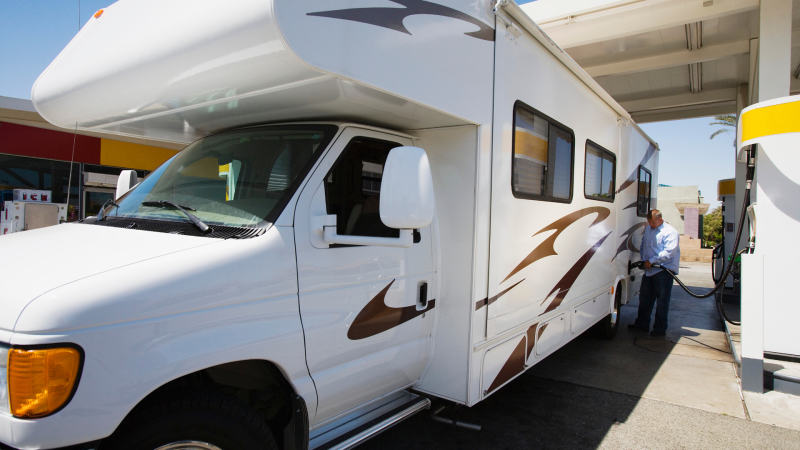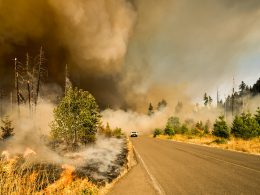You might think that a simple liquid like water wouldn’t damage your vehicle’s engine much. It’s safe; there are no chemicals, no problem, right? Actually, water in your gas tank could compromise your safety and the safety of others on the road because your vehicle doesn’t operate as it should. It’s dangerous to get water in your gas tank. So today, we’re providing the symptoms and solutions to this serious problem. Let’s dive in!
HOT TIP
Be sure to read How Do You Dump Tanks While Boondocking before embarking on your next road trip!
How Does Water Get In Your Gas Tank?
Rain and condensation are the two most common reasons water enters your gas tank. Living in high-humidity areas makes you more likely to get water inside your gas tank, too. In addition, if you have a weak seal, water will get inside if it rains.
Most of the time, uncontrollable forces are the causes behind water getting in your gas tank. We know no one would intentionally put water in their gas tank, but you could cause water to get inside if you leave off the gas cap for a couple of days and it rains.

Is Water In Your Gas Tank Problematic?
Yes! You could experience severe problems if enough water enters your gas tank. Unlike gasoline or diesel, water isn’t chemically capable of fueling an internal combustion engine. This could lead to an engine malfunction, which could be very costly. Because water also leads to corrosion and rust, it can damage components or deposit debris in the fuel lines and spark plugs. These repairs could also be expensive.
What Are Symptoms That Water Is In Your Gas Tank?
Thankfully, there are tell-tale signs of water in your gas tank. Sudden sputtering and poor performance are the first symptoms. Your vehicle may not accelerate like normal because the right fuel isn’t feeding the engine.
On the other hand, your vehicle may accelerate when it’s not supposed to. The out-of-the-blue power surges are also the result of an engine not functioning correctly because too much water is mixed in with the fuel.

You might also experience problems starting the engine. If water is on top of the piston, the combustion needed to rotate the piston won’t occur since water doesn’t have the properties and chemical composition of gasoline or diesel.
Finally, another common symptom is a strong gasoline smell. If you smell this, don’t automatically assume you have water in your gas tank, though. There are other common reasons for you to smell a strong fuel scent, like unburned fuel vapors from the tailpipe or a simple fuel leak.
However, if you experience other symptoms like poor performance, misfiring, and other engine problems, in addition to a strong gasoline smell, you likely have water in your gas tank.
How Do I Get Water Out Of My Gas Tank?
You don’t want to keep burning fuel with too much water. If you catch the problem soon enough, you won’t have to pay a mechanic to drain the fuel. Instead, you can use a drying agent like Iso-HEET. This additive removes water and moisture and cleans fuel injectors and carburetors. You’ll need to read the instructions to know how much product to use. Typically, a 12-ounce bottle treats 20 gallons of fuel.
K-100 Gasoline Fuel Treatment and STP Water Remover are other products that help eliminate water in your gas tank. Of the three, we recommend Iso-HEET. It’s the cheapest option but has excellent reviews from users. It also prevents gas lines from freezing.
- Inhibit corrosion
- Prevent fuel line freeze
Are There Long-Term Effects Of Water In My Gas Tank?
No matter how hard you prevent this from happening, a tiny bit of water will get in your gas tank. When a large amount mixes with your fuel, you’ll start to experience problems. A long-term effect could be damage to your injectors due to corrosion. If the injectors fail, your car won’t start, and a simple jump from a neighbor won’t solve the problem.
Other Preventative Measures To Keep Water Out Of Your Gas Tank
Although you can’t control when a small amount of water gets into your gas tank, you can take a few preventative measures. After heavy rainfall, check your gas cap and note any water. When you loosen the cap to fill up, inspect it to ensure there are no cracks or broken pieces. If you don’t hear a depressurizing sound, it’s time to replace your gas cap.
Thoroughly inspect your vehicle monthly. Look for rust or corrosion. If you start to feel inconsistent acceleration or misfiring, it’s time to buy an additive to protect your engine and its components.

Don’t Let Water In Your Gas Tank Escalate To Worse Problems!
If you suspect water in your gas tank, don’t just shrug it off. This is a serious issue that needs to be appropriately taken care of to ensure your vehicle operates correctly and safely. You don’t want to all of a sudden accelerate when you’re driving through a school zone. You don’t want to wake up and head to work to find out your car won’t start. Water in your gas tank can be dangerous and costly. So do your part to prevent this from happening and know what to do if it does.
If You Want the Latest Travel News, Join Our Mailing List
Don’t rely on biased RV industry news sources to keep you informed. Stick with Nomadic News. We publish articles and breaking stories that matter to you every weekday.
Have you ever had water in your gas tank?
Last update on 2025-06-26 / Affiliate links / Images from Amazon Product Advertising API











